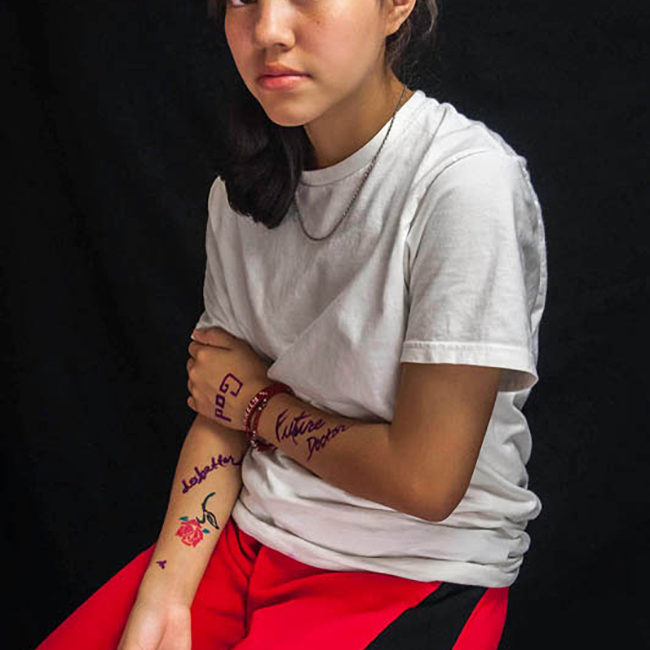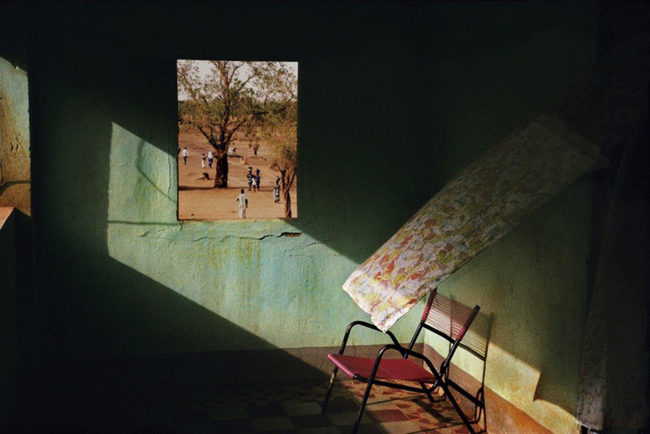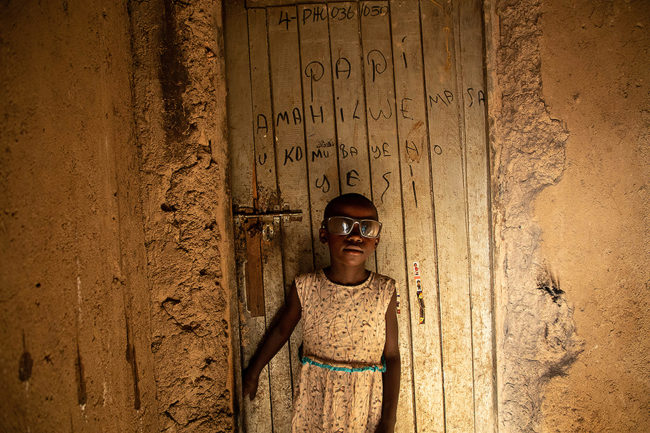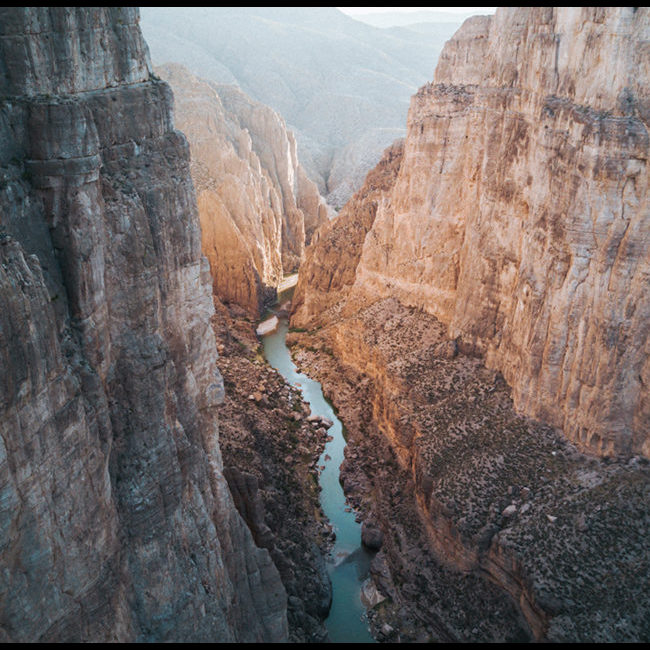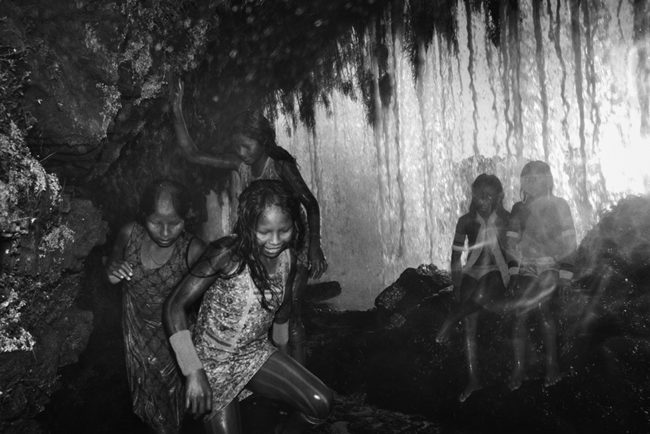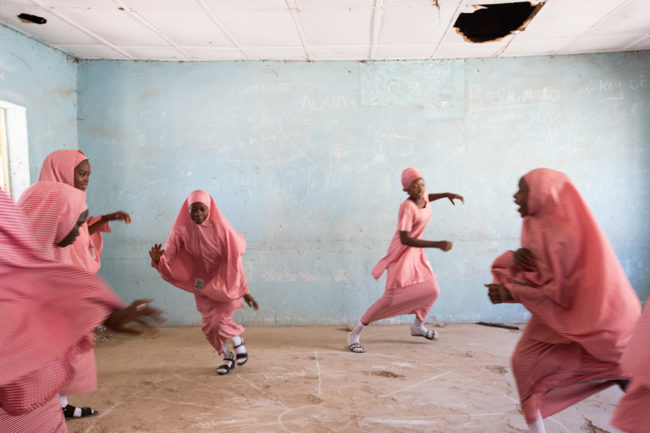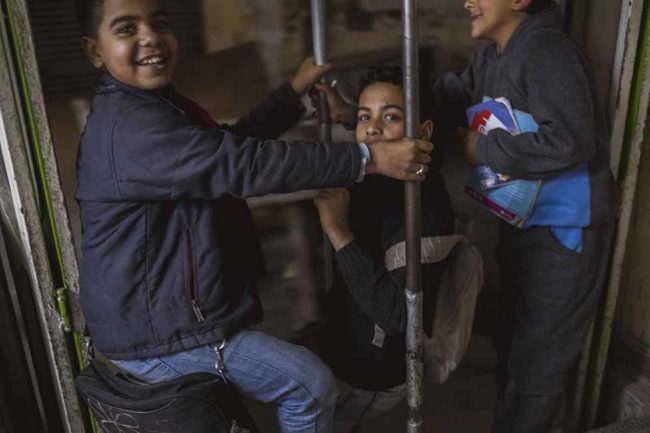In the social media era, where private life is increasingly elusive, what does intimacy mean? “Up Close & Personal,” a selection of images from Magnum photographers, asks what defines an intimate photograph. The answers are understandably varied. Some depict the personal life of the photographer or catch a private moment between strangers; some mark important milestones in the photographer’s development or show an intense connection between photographer and subject. All strive to evoke the emotional, mysterious bond that connects viewers to images. In their own words, close to 60 photographers from throughout Magnum’s history describe how the images were made and what they mean.
A smiling baby gets a bath in the kitchen sink in Stuart Franklin’s 1996 image:
“It’s a hot summer day. My youngest son Billy, age two, is cooling off in the kitchen sink of his aunt’s house in Anglesey, Wales. Windfall apples, from the orchard outside, lie on the draining board awaiting transformation into apple crumble. Phoebe, the gentle labrador, noses around the back door curious to see what’s going on. Today, Billy is starting university. Time flies, but photographs allow our intimate moments to stay on as cherished memories. Photography that is intimate always conveys a sense of the photographer being not just there, but included, welcome, accepted.”
In a plainly-framed portrait made in Teheran in 2010, Newsha Tavakolian photographed a beautiful acquaintance whose eyes brim with tears:
“In Iran I get a lot of requests to shoot the lives of young people, as if the way they live is that much different from other youths in the rest of the world. I photograph them in malls, driving cars and in cafes, but at some point I wanted to also expose their feelings. For a long time I juggled the idea of how to create a different way of intimacy. After some failed attempts, I decided to turn my own apartment into a studio, and have neighbors and friends come over to have their portraits taken. Naghmeh is one of the most popular young women in Tehran, she’s beautiful, smart and funny. I took pictures of her in total silence. Suddenly, her face expressionless, tears started welling up in her eyes, as if she was trying to show me something. Afterwards she said goodbye quietly and left. Later, when I had the image framed, one of the glass plates had a scratch on it and the framer asked if he could keep it. He hung it in his shop. Customers debated, wondering why she was so sad. ‘You could write a book with all the stories people come up with when they see this portrait,’ the framer told me. I never asked her why she cried.”
Framed by the window of a train, a man and woman engage in an ambiguous embrace in Thomas Dworzak’s “Do Not Lean Out. Russia. Sochi. Tuapse-Maikop. Suburban train (Elektritshka),” 2013:
“I was traveling up and down the Russian Black Sea coast in the months before the Olympics, on local trains. I only caught a fleeting glance of this couple’s intimate moment on an empty railway platform, hugging, playing, kissing, arguing, fighting… who knows? They were oblivious to the passing train. An accelerated version of what often happens traveling and covering stories: entering people’s lives, spending some time with them, and moving on….”
A woman in scanty leather shakes hands across her motorcycle with a shirtless man in Constantine Manos’s “USA. Florida. Daytona Beach,” 1988:
“This photograph, which might be entitled ‘First Encounter’, was made on Main Street in Daytona Beach, Florida, in 1988 during the annual Bike Week—when thousands of bikers pour into the small town to ride their bikes around and have fun. Main Street was lined with parked motorcycles, their owners perched on the seats watching the parade of roaring bikes go by. Looking for pictures, I had my eye on this female biker with a beautiful body when a male with a beautiful body approached her. Cutting out the faces, I concentrated on the handshake: the first encounter of two bodies. When I left, they were engrossed in deep conversation. Who knows what happened after that?”
The form of a child is silhouetted against bright curtains in Jim Goldberg’s 2002 image, made in San Francisco, “Ruby 1st day of Spring”:
“On May 1, 2000, my Mom died suddenly (it was due to a doctor’s negligence but that’s a whole other story). My daughter Ruby and I got on a plane to Florida to attend the funeral, pack up the house, and disperse her belongings. The day after the funeral while my sister, brother and I were clearing out my parents home, I looked up and saw Ruby playing amongst the curtains. She was 8 then, and having her there is what helped me through it all. Photography did too.”
Framed by a window into a crowded dining room, a woman cradles a baby in Micha Bar-Am’s “A Passover ‘Seder’ in the dining room of the Kibbutz Kinneret,” 1979:
“The dining room is the heart of the collective settlement called Kibbutz. It is noisy and lively. I sneaked out to capture this intimate moment: we photographers always try to capture the elusive moment of intimacy.”
Wind blows the skirts of three smiling women in Guy Le Querrec’s “Cote d’Azur. 1956. Phare d’Antibes (Alpes-Maritimes)”:
“This is one of the very first pictures I took. It was 1956, at the top of Antibes lighthouse on the French Riviera and I was a young boy. The woman in the middle with her hands in her hair and a bright smile is my mother. As the wind blew up her skirt, and before Marilyn made the move famous, I stopped hiding behind her. I was 15 years old, but it didn’t take me seven years to develop the itch to take pictures!”
In a room lit by a single red light, a woman in a white nightgown lays across the bed in Bieke Depoorter’s “I Am About To Call It A Day,” 2011:
“By asking people I accidentally meet on the street to spend the night in their home, I often enter in the intimacy of people’s lives. I like to photograph the moment when the night falls and people return to their homes, close their doors and put their nightwear on. In between two days, when no one is looking, there is a little moment where the facade falls away. I find it very difficult to choose my most ‘intimate photograph’, because I experienced so many. People often shared their bed with me; I fell asleep while children and mamas were holding me tight, in a single-bed next to a very old Mexican woman who prayed for my family in the middle of the night. People invited me into Russian saunas and into American hot-tubs and when I was welcomed by an old couple in Bosnia, the man of the family died that night. But after consideration, I would like to share a photograph with you that is part of my book “I am about to call it a day.” While being together in …. ‘s bedroom and after photographing her, I realized something important. Photography is about sharing, it is a conversation that goes in two directions. It was not only me that observed her, but through me, she looked at herself. After a long time together in her bedroom and after this picture was taken, the woman stood up in her white night dress, crying intensely; she gave me a long hug and went to sleep.”
Signed and estate-stamped prints from “Up Close & Personal” are available for $100 until 11pm on November 13 through Magnum at store.magnumphotos.com.
